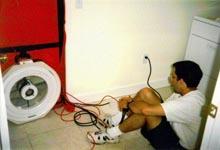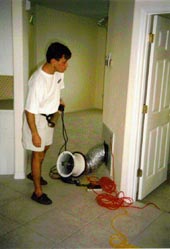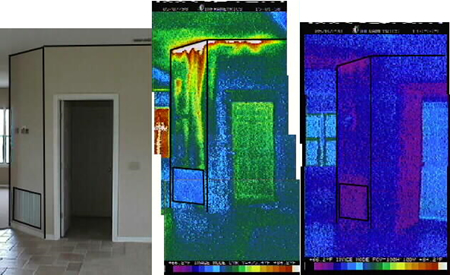
![]()
Building Envelope
House and Duct Airtightness
 |
| Figure 23. Blower Door |
|---|
Air infiltration can represent a major cooling load in Florida's hot and humid climate. We used a Minneapolis blower door (Figure 23) to measure house tightness in both homes on April 22, 1998. For the Control home the total overall building tightness of the control house was 2,025 CFM50 or 6.3 ACH50 with a house equivalent leak area (ELA) of 95.2 square inches. The overall tightness of the PVRES home was 1587 CFM50 or 4.9 ACH50 with a house ELA of 69.0 square inches. For Central Florida's climate, a useful rule of thumb to determine the house natural air infiltration rate is to divide the house ACH at 50 pascals by 30. This would estimate a typical natural air change rate of about 0.16 ACH in the PVRES home and 0.21 ACH in the Control. In both homes, we noted that much of the leakage to the outside appears to be from the 30 recessed lighting cans in the ceiling.
 |
| Figure 24. Duct Blaster |
|---|
We used a Duct Blaster™ (Figure 24) testing device to determine the relative leakage in the return and supply sides of the duct systems in both homes. In the Control home, the total CFM25 leakage of the duct system to outside the conditioned space was 122 CFM25. Given its 2,425 square feet of conditioned area, the duct leakage to outside is 0.05 cfm/ft2. This compares to the 0.03 cfm/ft2 proposed as a standard for utility new homes programs. In the PVRES home, the total CFM25 leakage of the duct system from outside the conditioned space was 50 CFM25 or about 0.021 cfm/ft2 - a low value.
In summary, we found that the tightness of the duct system of the Control
home was very average relative to most homes which we have tested. One limitation
of the test, however, is that with the air handler operating, all the leaks
are not the same. Ceiling penetrations close by the air handler can bring
air from the attic -- air that is super heated in the Control home. Moreover,
any of the 50 cfm air that is unintentionally drawn from the attic is being
taken from a space that typically gets no hotter than the outside ambient
air temperature. The PVRES home, with its interior duct system, on the other
hand, had as low a leakage to the outside of the building of any that have
been tested by FSEC.
Evidence of unintended air leakage in the Control home from the attic
to the air handler casework in its interior closet was clearly seen in infrared
thermography on the air handler (Figure 25). This is contrasted by the lack
of such leakage with the interior duct system in the air handler case itself
suggests that ceiling penetrations by the air handler closest will lead to
air being drawn from the space. It also suggests the great hazard of allowing
air handlers to be located within attic spaces.
 |
| Figure 25. Comparative thermographs of air being drawn from the attic to the air handler in the Control house (center). The interior duct system in the PVRES house shows no problem of this type. |
|---|
Our test results indicate a fairly tight building envelope
for both homes, with the PVRES home somewhat better. However, the
leakage duct systems for the two homes show large differences, mainly due
to interior duct system in the PVRES site. Moreover, thermography
showed that the leakage from the attic to the air handler at the
Control site has disproportionate impact on cooling efficiency.
Measured Building Air Infiltration Rates
To supplement the blower door test, we evaluated the in situ air
infiltration rate in both homes using sulfur hexafluoride (SF6) tracer
gas decay. The blower door indicated that the PVRES home was tighter
with less leakage area, but how the tightness will impact actual
air leakage rates is strongly influeanced by the operating pressures
within the building, particularly when the mechanical air distribution
system is operating.
Both homes were evaluated on May 20, 1998 with the air handler on
and off. The tracer gas concentration decay was measured by two Bruel & Kjaer
Model 1302 multi-gas monitors over a one hour period subsequent to SF6
injection. The air handler off test provides information on the "natural
air infiltration rate" from air leakage driven by temperature differences
and wind on the external building envelope. The air handler on test
shows how operation of the mechanical air handler equipment can impact
the overall building leakage rate in air changes per hour. Past studies
have shown that operation of the air handler will typically increase
building air leakage rates by two to three time the "natural" rate
which is typically low in Florida homes due to the small driving forces (bouyancy
and wind) [10]. However, we would expect the interior duct system in
the PVRES home to somewhat reduce the relative impact.
Table 4
Measured House Air Infiltration Rates
SF6 Tracer Gas Decay Test
Case
DescriptionAH
StatusAir Changes
Per HourInterior Temp
(oF)Exterior Temp
(oF)Wind Speed
(m/s)Control Off
0.131
76
90.6
5.2
Control On
0.349
76
89.9
8.0
PVRES Off
0.085
74
86.5
9.5
PVRES On
0.131
74
85.6
10.2
The PVRES home evidenced tighter construction in all cases the air change
rates were low. The natural infiltration rates (air handler off) were 0.085
and 0.131 ACH in the PVRES and Control homes respectively. The air change
rates with the air handler operating was 0.131 in the PVRES and 0.349 in
the Control revealing that the air handler operation increased building air
leakage by 54% and 266% respectively.
It is important to note that in all the cases the building ventilation
rate was low relative to the recommended rates within ASHRAE standard
62-1989 of 0.35 ACH [17]. However, it cannot be argued that the higher
infiltration rates for the Control home are better, since much of the
infiltration air is coming from an undesirable location (the hot attic).
The data do suggest, however, that some system of mechanical ventialtion
with heat and enthalpy recovery may be desirable for future homes of this
type.
